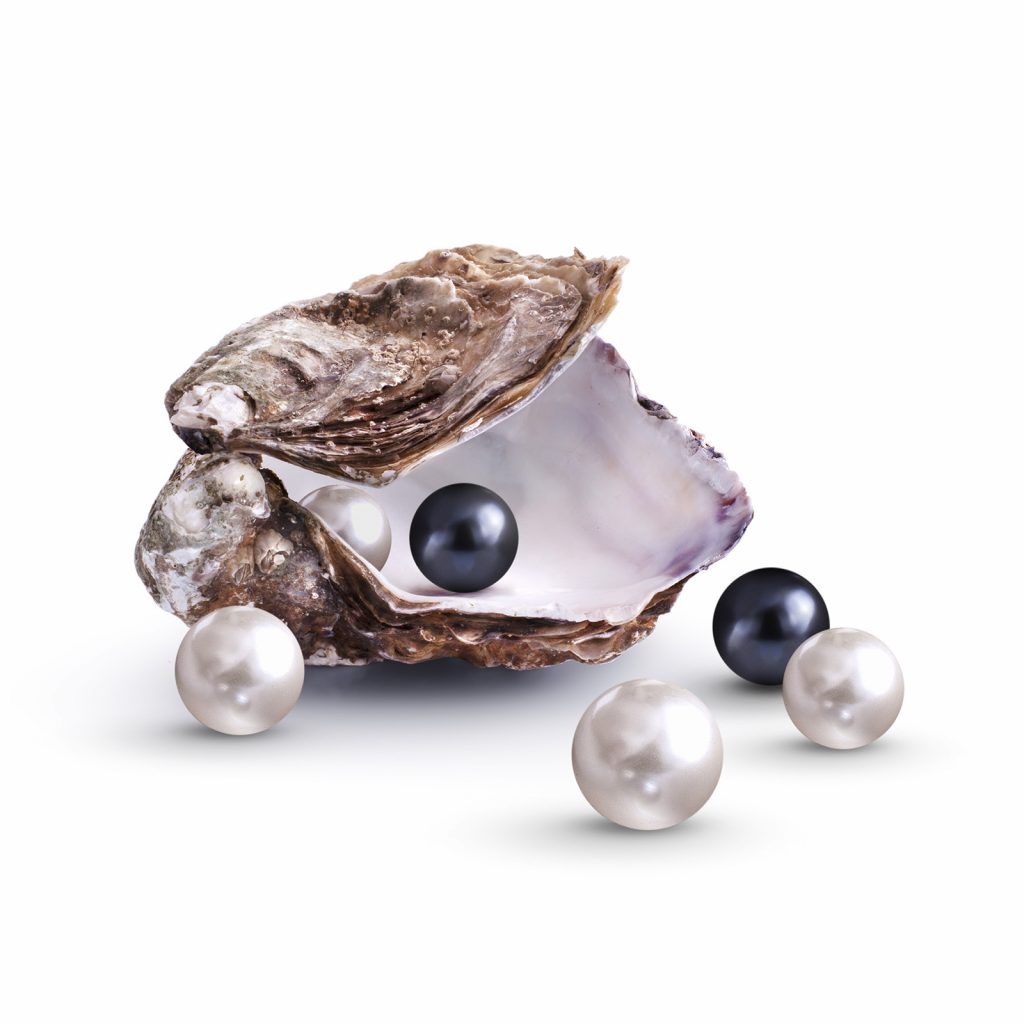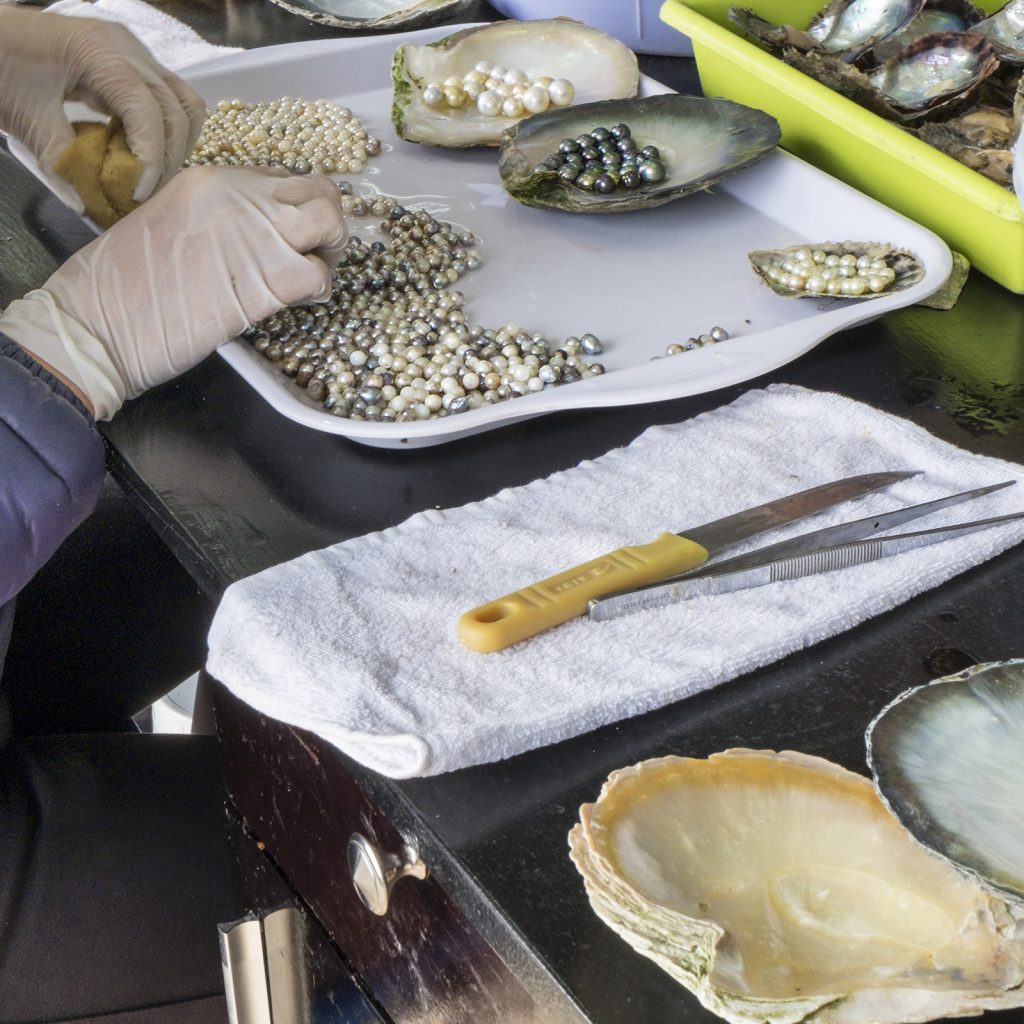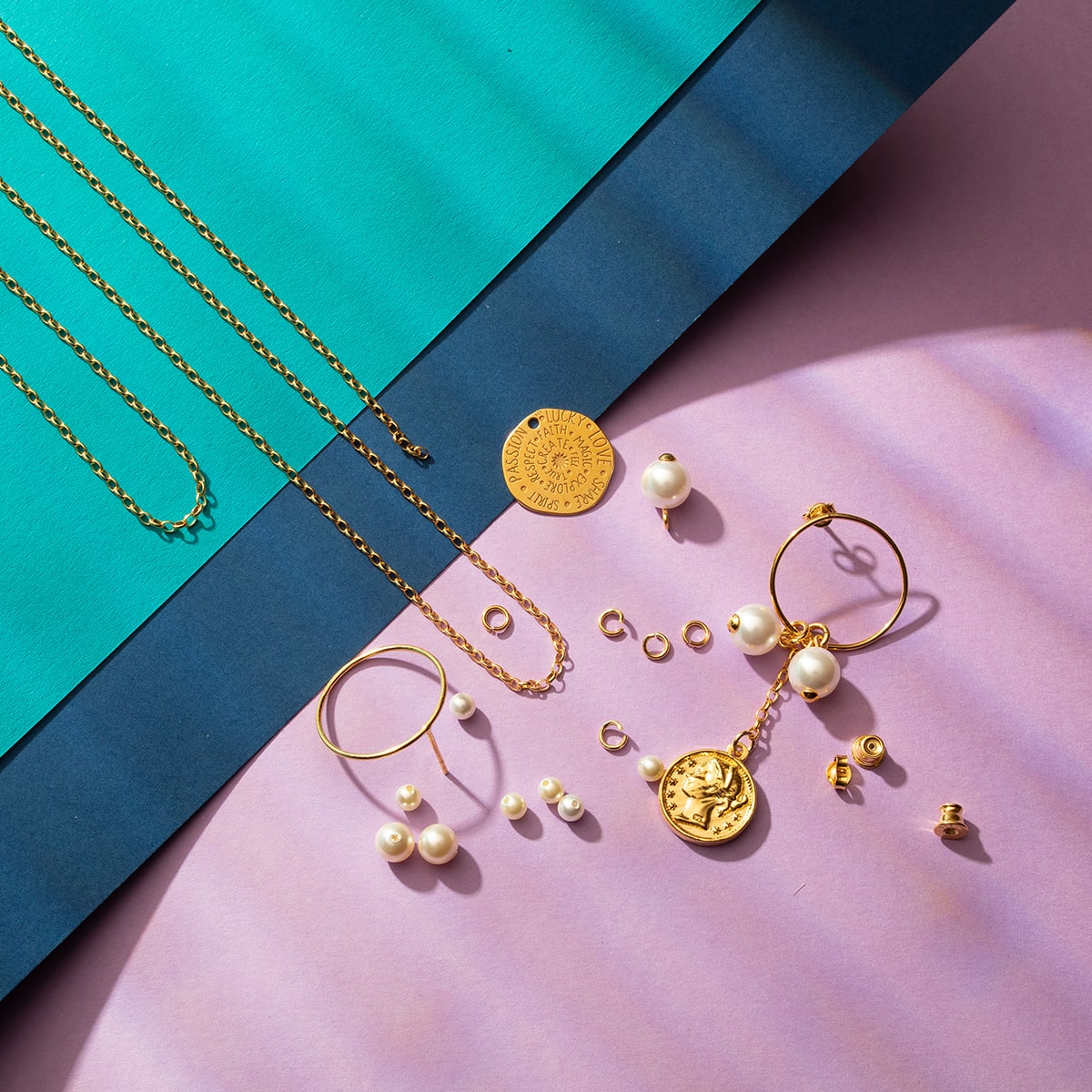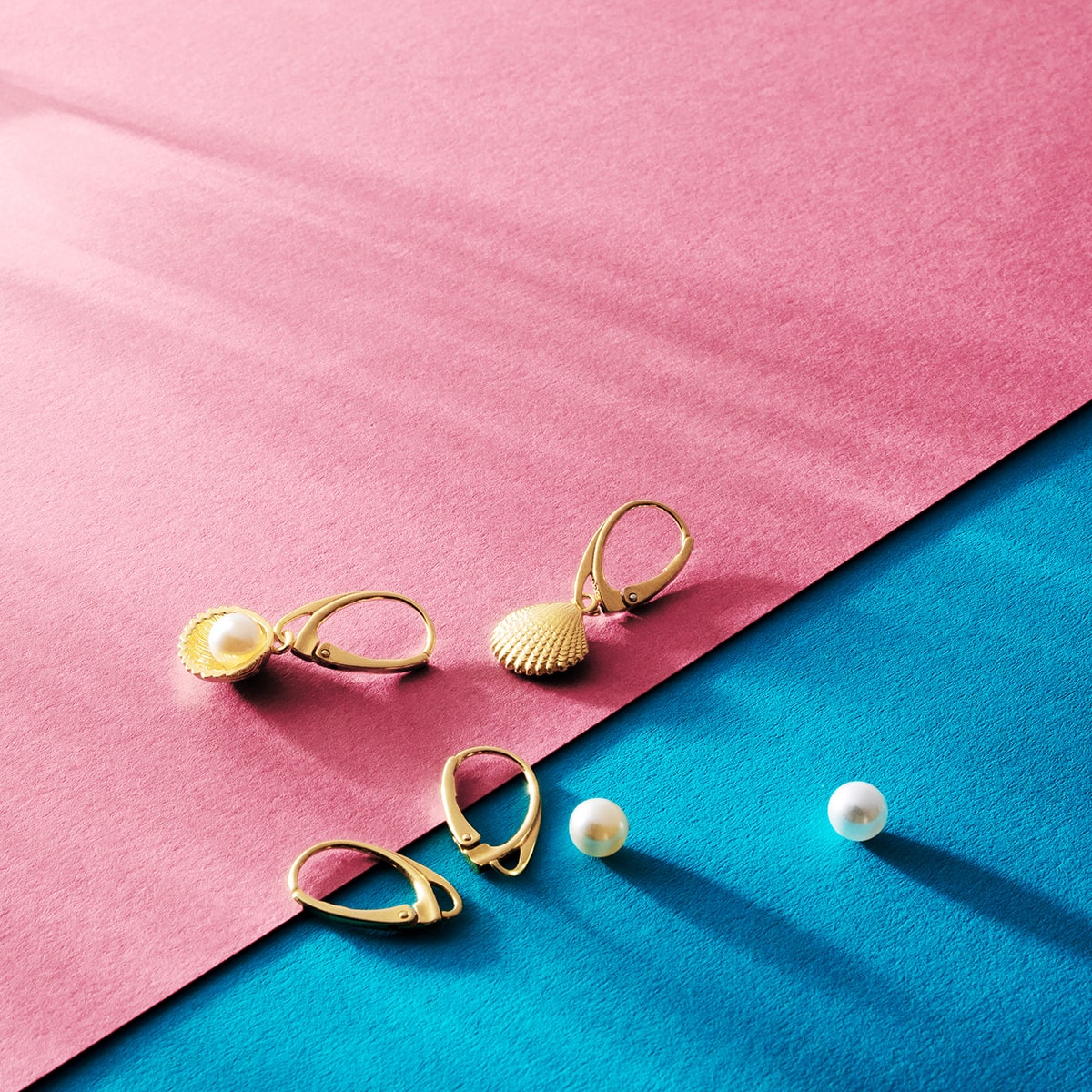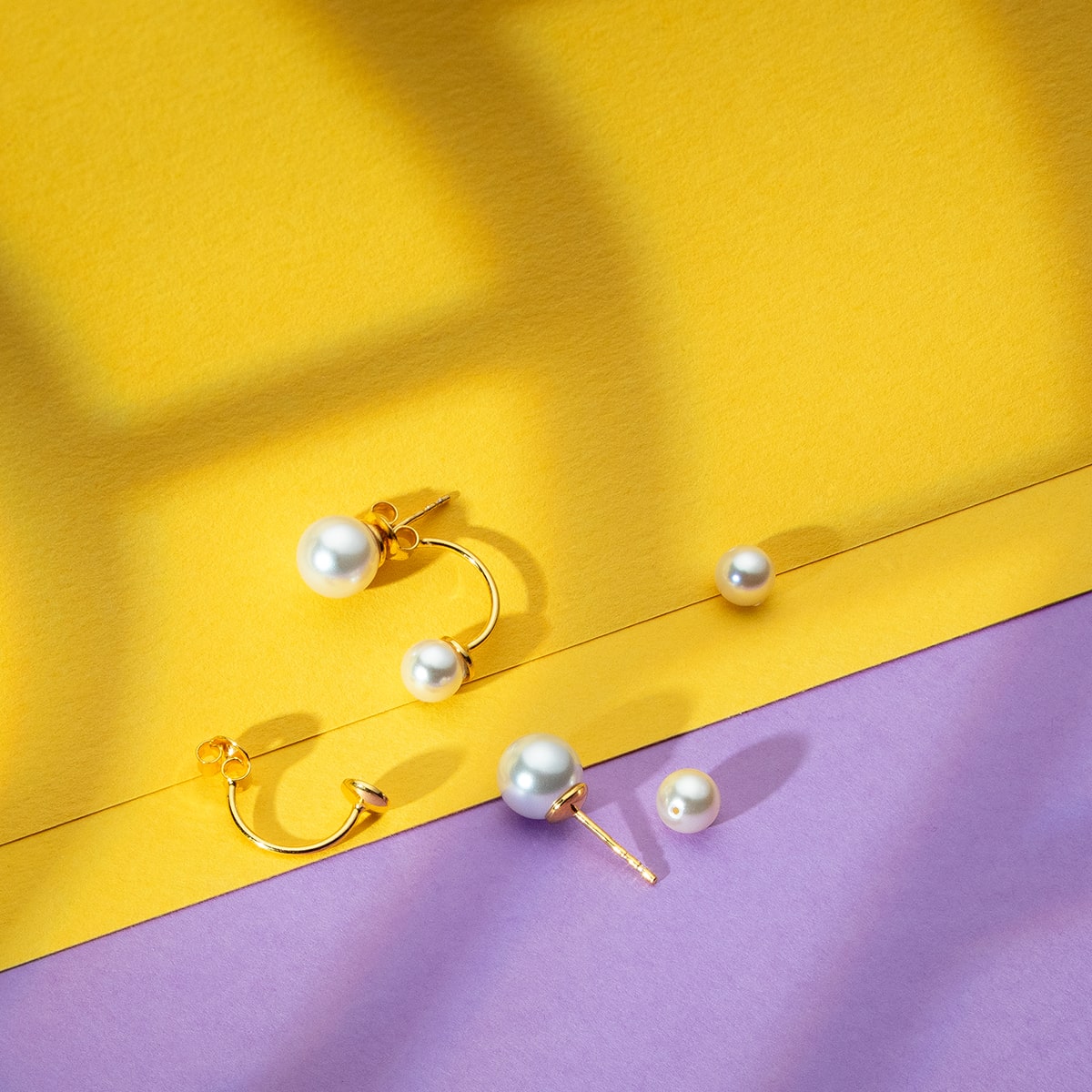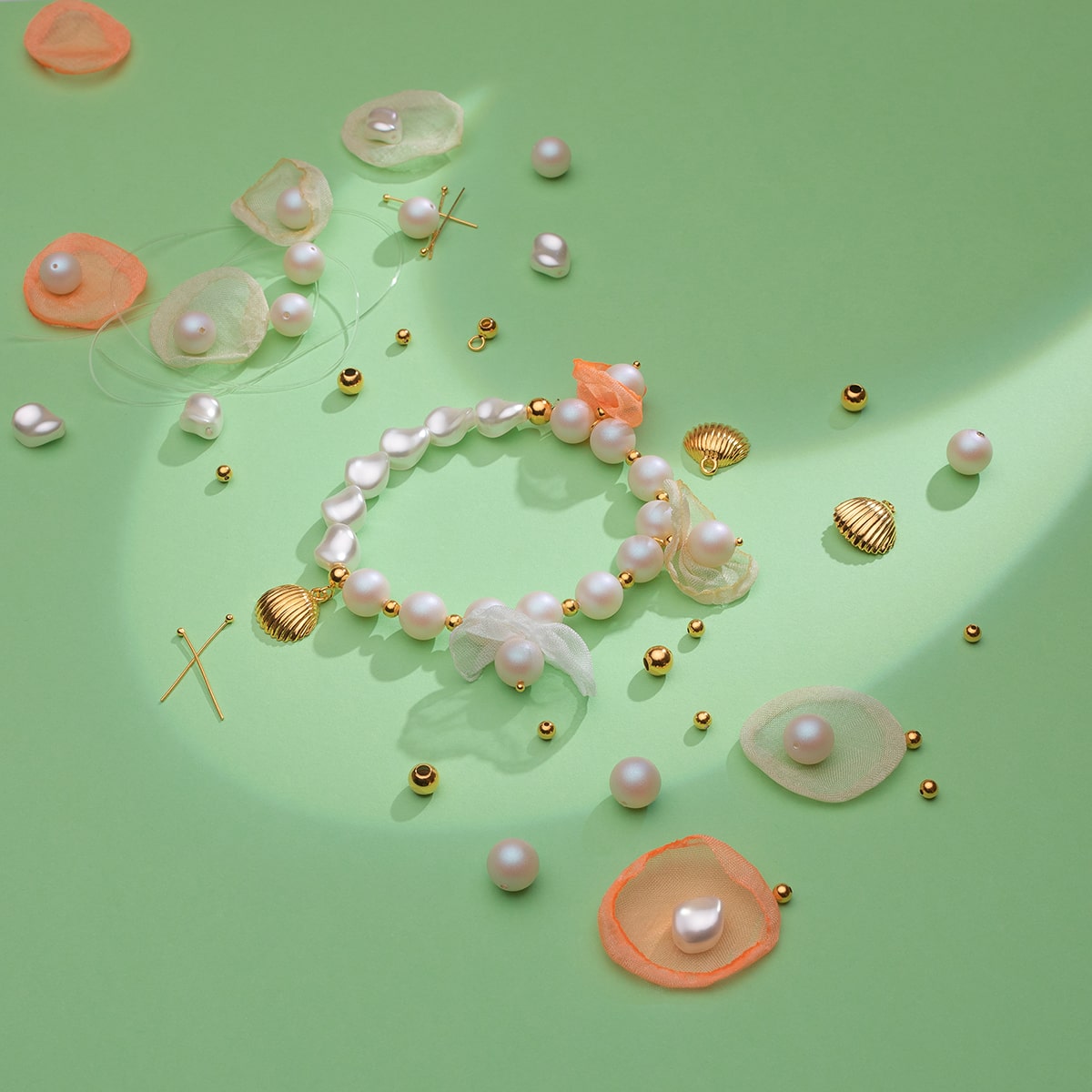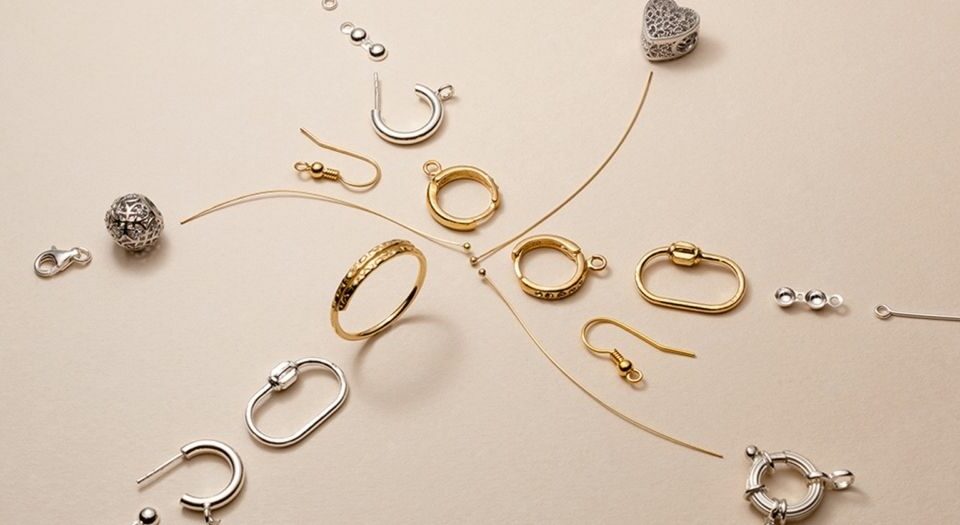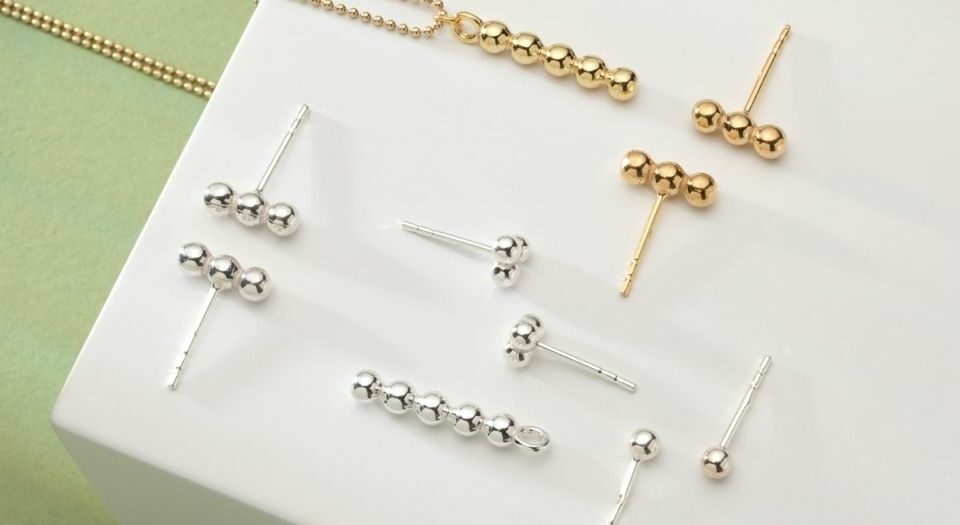
Epoxy resin – colorless jewellery glass
March 30, 2022
Silver 3D jewelry castings
April 11, 2022Pearls are timeless, elegant and precious and have always been associated with wealth. They were desired and highly valued already in Ancient Egypt, Greece, Rome, as well as India and Persia, where they were used to decorating crowns, rings, brooches, and later also church garments and ceremonial women’s robes. However, only a few could afford such luxuries. Due to their rarity and the difficulty of collecting them, they were considered more valuable than gold.
The value of pearls depends on many aspects, such as:
- size,
- shape,
- color,
- luster,
- surface smoothness,
- transparency.
and if you buy more – their price is also influenced by the fit and similarity of each piece.
Pearls can be used for jewelry making such as earrings, pendants, rings, brooches, as well as more creative jewelry, accessories and clothing. The most valued are round pearls with unique luster, which dominate the market and can often be found in the form of jewelry made of only pearls like real pearl necklace, or combined with gold 585 and silver 925.
Pearl jewelry fascinates both young and mature women, so it is worth finding out more about the types of pearls, their origins, which pearls are real, and how to distinguish them from each other, as many jewelers use fraudulent tricks. The most popular international pearl quality rating scale used by jewelers, is the classification using the following symbols: A, A +, AA, AA + and AAA, where pearls marked with AAA are of the highest quality. The rating is influenced by the size, shape, color, surface, luster and thickness of the mother-of-pearl.

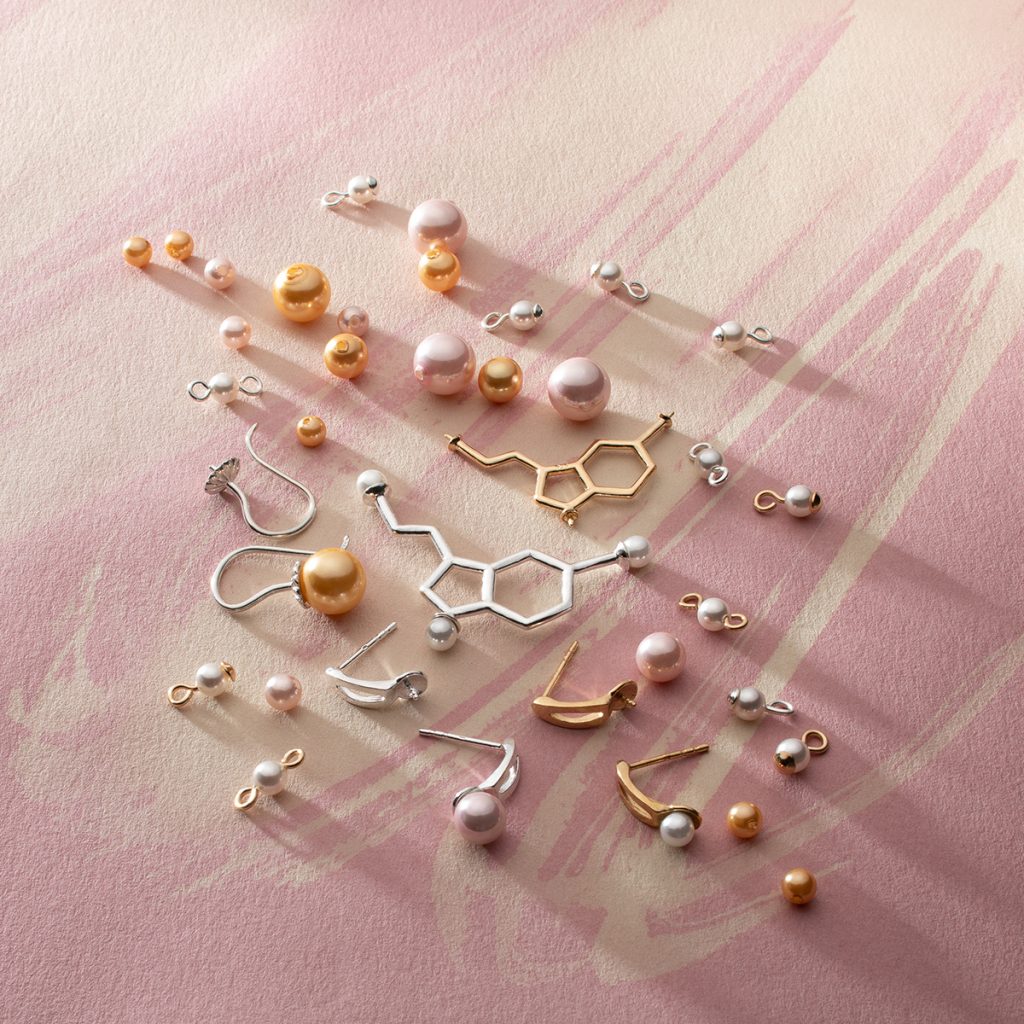
Types of pearls
We can divide pearls according to their origin, color and shape:
Due to their origin we can distinguish:
- natural pearls,
- cultured pearls,
- synthetic pearls.
In terms of color, we can distinguish:
- white pearls,
- black pearls,
- brown pearls,
- blue pearls,
- green pearls,
- cream-pink pearls,
- pink pearls,
- fancy pearls,
- cream-pink fancy pearls.
In terms of shape, we distinguish:
- round pearls,
- oval pearls – shaped like a grain of rice,
- baroque pearls also called mishappen pearls – they have unique, random and irregular shape,
- half flat pearls, semi-convex pearls,
- quarter pearls – three-quarter oval and one-quarter flat,
- drop-shaped pearls,
- button-shaped pearls – one-sided flat, slightly convex,
- grain-shaped pearls – small and asymmetrical.
Where pearls come from?
Natural pearls, also called wild pearls or real pearls, are organic gemstones, that are naturally produced inside the shells of mollusks, known as pearl oysters, that inhabit the seas and oceans. The pearl is made of mother-of-pearl, the same that lines the inside of the shell of a mollusk, and is composed of calcium carbonate and protein substance.
The formation of pearls has a place, when a small bit of seaweed or tiny crab get stuck in a mollusk, so the oyster protects itself by wrapping the intruder with nacre. Their uniqueness results from the fact that the creation of a real pearl is extremely rare. Out of many thousands of mussels, only one produces pearl, which is why it is valued more than gold and, unlike other gemstones, it is not mechanically processed.
What is more, its natural state has a beautiful shine. Moreover, a pearl can be compared to a fingerprint, because there are practically no two identical copies. The size of the pearls is very diverse, and ranges from 1 mm to about 15 mm in diameter. The color of pearls depends on the species of mussels and the type, quality and temperature of the water, in which they live.
In addition to natural pearls, which are formed in oysters living in salt waters, referred to as saltwater pearls, we also encounter pearls that occur sporadically in snails, as well as in freshwater pearl mussels, referred to as freshwater pearls. Unfortunately, the devastation of water reservoirs led to the destruction of freshwater mussels that naturally produced pearls.
Real pearls wear out and age, what is visible in getting mat, cracking, peeling, chipping off, and finally scattering into a fine powder. The life of a natural pearl is estimated at about 100-150 years, but there are few specimens up to several hundred years. Attempts have been made to restore pearls, mainly to retrieve their color and brilliance, but no methods have achieved satisfactory results.
The great desire and rarity of real pearls led to the emergence of pearl cultivation, which led to the development of mass production of pearls, which are referred to as cultured pearls or farmed pearls. At the beginning, a skilled technician inserts a piece of nacre or tissue of sacrificed mollusk, into the pearl mollusk’s shell. Then the mollusk is returned to the water and starts to protect itself by producing layers of nacre, and wrapping them around implanted piece inside its shell. Pearls require human intervention and care while being formed, and about two years later, pearls are harvested. In order to speed up this process, a bead the size of a grain of sand is placed in the shell, around which a mother-of-pearl is formed. The smaller the bead, the more space is left for the construction of the mother-of-pearl, which adds value to the pearl.
Farming pearls is very laborious, tedious and requires a lot of knowledge and experience. An average farm of about 50,000 pearls, after about two years, obtains about 40% of pearls suitable for jewelry production, where just 10% qualify for high quality.
Cultured pearls are also divided into saltwater pearls – called sea pearls, and freshwater pearls – that grow in rivers, lakes and ponds.
Cultured saltwater pearls are rarer, more beautiful, more valuable, and much more difficult to farm. The most famous of them are:
- Akoya pearls grown in Japan, reaching 2 to 10 mm, they are characterized by light shades,
- Tahitian pearls or french pearls, reaching 8 to 18 mm, sometimes called black pearls but their colors include gray, blue, green and purple,
- South Sea pearls from Australia, shimmering with golden shades, referred to as queen of pearls.
Cultured freshwater pearls are much cheaper and less demanding to farm, which has made them more popular. An additional advantage is the possibility of obtaining several pearls from one clam. The disadvantage, however, is their quality, which is much lower than that of sea oyster pearl, which makes them less attractive.
The appearance of a pearl is influenced not only by the type of water in which the mollusks are grown, but also by its temperature. In cold sea waters, pearls grow slower but have a greater luster, while pearls from warm lakes and rivers grow faster but have a duller surface.
Natural Pearls vs. Cultured Pearls
Cultured pearls resemble natural pearls, which makes them very difficult to differentiate by comparing only their appearances. However, few methods have been developed that make it possible to distinguish one from the other. The first method is to find differences in the inner structure of pearl using X-rays. By applying this method, we obtain results, that help us classify the pearl:
Natural pearl:
- no implanted bead inside the pearl,
- all layers of the pearl are arranged in circles,
- smooth surface,
- lower density,
- the overexposed image is a hexagon made of black dots,
- the effect of radiography is a bright area,
- their transparency causes optical phenomena causing shine and play of colors,
- natural pearls thrown onto a glass surface from a height of 70 cm bounce off it to a height of 30–40 cm.
Cultured pearl:
- implanted bead inside the pearl, which is brighter than the other layers,
- in the case of non-bead pearls, the presence of a small hollow area,
- possible subtle surface roughness,
- higher density,
- the overexposed image is a quadrilateral made of black dots,
- the effect of radiography is a bright area, that is clearly cut off from the outer layers by a black borderline,
- cultured pearls thrown onto a glass surface from a height of 70 cm bounce higher than natural pearls.
Despite the greater availability of cultured pearls, they can still cost a lot, and their value depends on the quality, which is influenced by: size, shape, color, surface, luster and thickness of the mother of pearl. Due to growing demand of pearls, and much easier and faster raising the mollusks in pearl farms with conditions similar to nature, at the beginning of the 20th century, the natural pearls harvesting has become unfavorable, so natural pearls became even more rare.
Although you can find single specimens on the market today, they are usually found occasionally by fishermen, while collecting oysters and snails. They are very costly and mostly being sold to auction houses, collectors, or traded as antiques and trophies.
The rarity of natural pearls, continuous improvements of raising cultured pearls, as well as the growing demand for pearls, made the International Congress of Jewelers in 1926 stated that there is almost no difference between cultured and natural pearls, so both can be called real pearls.
Today, almost all pearls for jewelry making sold in the world come from farms, which require a lot of time and experience, therefore the market is flooded with more and more equivalents imitating real pearls. Unfortunately, jewelers often take advantage of customers’ lack of knowledge and define their jewelry as decorated with real pearls, so it is worth getting familiar with the most popular imitations of pearls, and learning to distinguish them from the real ones.
Pearl imitations
In addition to real and cultured pearls, the market also includes pearl imitations, also called artificial pearls, which look like real pearls, but are usually made of glass, plastic or shells, and are enameled to resemble the surface of natural pearls. There are many types of pearl imitation:
- silver fish pearls – glass pearls covered with ground scales of freshwater fish of the carp type, which create a refraction of light, and a shine similar to natural,
- Mabe pearl or Japan pearls – artificial pearls made by inserting seeds in a clamshell, then cutting it out, and replacing the seed with mother-of-pearl,
- Dugo pearls – made of a mass made of the teeth of the manatee – an aquatic mammal inhabiting the waters of North and South America,
- Antilles pearls – made of snail mother-of-pearl,
- seashell pearls – made of shell and mother-of-pearl, shaped into forms of drops and beads in various shades,
- Mallorca pearls – made of glass, plastic or porcelain, covered with bismuth enamel and cellulose acetate. They are very popular in Poland,
- French pearls – glass pearls covered with gelatin,
- imitations of pink pearls – made of snail shells and pink coral,
- imitations of black pearls – made by polishing hematite beads.
Due to high quality, pearls are most often combined with silver or gold. By choosing jewelry findings in the form of silver chains and pendants, you can make a beautiful floating pearl necklace. To create elegant earrings with a pearl, it is enough to order silver leverbacks for gluing a pearl. A pearl bail will allow to create a subtle pendant, which joined with silver chain will be the perfect complement to earrings. A pearl bracelet has become a hit of recent seasons, which can be easily created by pearl beads on an elastic string and adding decorative spacers or charms between them. When deciding on a pearl ring, all you need to do, is choose a ready ring setting and paste in the pearl.
Below are some examples of jewelry pearls:
Real pearls vs. fake
The dynamically growing popularity of pearls leads to the emergence of newer a nd more advanced solutions that really closely resemble real pearls, so it is worth getting to know few features that differentiate real pearls from imitations:
- The first is size. It is worth being aware, that real pearls are formed inside the shell of a mollusk, and therefore have a limited growth potential, so they can reach a maximum of 15 mm in diameter. Following this tip, if the pearl is larger than 15 mm, it is most likely an imitation.
- The second feature is shape. Natural pearls are rarely perfectly round, if you cannot see the difference in appearance, it is worth using a caliper. If the pearl turns out to be equal in each measurement, there should be a shadow of doubt, if the pearl is real.
- The third feature is the surface. In real pearls, the surface is rarely perfectly smooth, and there are often visible delicate rings and other imperfections. The roughness can be felt by rubbing two pearls against each other, if the pearls are perfectly smooth, they will slide, which will be a sign that we are dealing with an imitation.
- The fourth feature is a color that is rarely uniform. In white pearls, pink, yellow and blue shades are often intertwined, and in dark pearls, there are flashes of green, purple and navy blue. If you notice a different color around the hole, it is most likely that pearl is not real.
- The fifth feature is unique luster. In real pearls, the luster is alive, thanks to slightly visible transparent layers, it looks like it is coming out of the depth and naturally reflects light. In the case of imitation, the luster is slightly muffled, shallow and dark. However, the differences are so subtle, that it is difficult to notice such deviations without experience.
- The sixth feature is the thickness of the mother-of-pearl, that has grown around the seed. However, this feature can only be examined by using X-rays.
Apart from the six main differences, that affect not only the classification of pearls, but also their value, it is also worth bearing in mind that:
- real pearls are heavy, their weight is similar to glass or marble,
- real pearls are cold, and they change temperature while wearing,
- real pearls are elastic, after throwing them on a flat surface, they bounce up to half of height. In contrast, plastic pearls bounce higher and glass pearls lower,
- the authenticity of the pearl can also be checked by soaking in boiling water, when the real pearl comes out unscathed, and the imitation is damaged.
When buying pearl chain, a very important feature is their similarity in shape, size, color and surface. Real pearls will always be more or less different from each other, while the imitations should be identical. When deciding on pearls threads, it is also worth paying attention to whether there are knots between the pearls. In the case of real pearls, it is a common practice to prevent pearls from rubbing against each other, and also from spilling if broken. Strands with fake pearls won’t have such knots, because they require too much work.
Another example is the purchase of ready jewelry with real pearls. The high price of pearls means that they are usually combined with silver or gold, so if it has been finished with some other cheap metal, it suggests that the pearls are not real.
Interesting facts about pearls
- Legends say, that pearls are the tears of angels, and the oysters that form pearls, were fertilized by a rainbow touching the ocean.
- It has been believed for centuries, that a pearl worn close to heart, stimulates femininity, supports fertility, facilitates pregnancy and protects against evil charm and curse.
- In the 18th century in China, it was discovered, that a pearl can be formed on a grain of sand, placed in a mollusk shell, but it turned out later to be a myth, because the mollusk was able to remove it by increasing the production of mucus.
- Pearls are credited with tremendous healing power, a powdered form allegedly helps in the treatment of heart and circulatory system diseases, and after dissolving it in lemon juice or milk, it is used for mental disorders.z cytryny lub w mleku, stosuje się ją na zaburzenia psychiczne.
- The largest places, where pearls occur are the Persian Gulf, Mannar Bay, Red Sea shores, Madagascar, Burma, the Philippines, Northern Australia, Haiti, Florida, the coastal waters of Mexico and Panama, the northern coasts of South America, and the coast of Japan – however, in some places the harvesting conditions are very difficult and dangerous, and in some cases they are controlled by government inspectors.
- Pearl experts are able to classify pearls origin on the basis of their color and gloss.
- In Poland, pearls were grown in Lower Silesia in the 16th and 17th centuries, from the Sudeten populations of the pearl mussel, however this species is now considered extinct.
- Pearl measure is gran, where 1 gran = 0.05 g = 0.25 carat.
- The most valued in the world is round pearl, and in terms of color, pink pearls are the most expensive, then cream, white and black ones.
- Apart from pearls, mother of pearl is also high valued.
- Holes with a diameter of 0.3 mm are drilled in a defective or less aesthetic place, removing the imperfection, and if this is not possible, the defective part of the pearl is removed, and the remainder is sold as hemispheres or three-quarters.
- Pearls that are bred as cultured pearls are often referred to, however, this is a misnomer because you breed animals – in this case, mollusks, and the pearls themselves are dead.
- Apparently, women with pale skin more often choose pink pearls, and women with dark hair, prefer cream pearls.
- There are many types of pearl necklaces, and they come in various lengths: – necklace with pearls of the same size is called uniform, – necklace with changing uniformly from ends to center is called graduated, – necklace made of pearls around 40 cm long is called collar, – necklace reaching near collarbone is called princess, – necklace made of pearls between 50 and 60 cm long is called matinee, – necklace made of pearls around 80 cm long is called opera, – the longest length measuring about 90 cm is called rope.
Pearls have always intrigued and attracted attention due to their natural beauty, rarity and magical powers, that have been attributed to them, since ancient times. Although all pearls in the world circulation are raised on farms, they are still considered a symbol of luxury, wealth and timeless beauty. Pearls in jewelry add elegance, increase its value and prestige. Unfortunately, many jewelers and sellers do not clearly specify, whether the pearl is an imitation, which is required by international standards, so it is worth having at least some basic knowledge, and learn to distinguish them, or be vigilant, and consult trusted jewelers and buy from reputable sellers. 925CRAFT, as a manufacturer and jewelry findings wholesaler offers cultured pearls GAVBARI, so we encourage you to familiarize with the wide range of products, and contact us if you have any questions or concerns.
Do you want to find out more?
Explore wide offer of jewelry supplies and jewelry services of 925CRAFT
If you found this article valuable, we would be grateful if you like, share with others, or comment, which will be an energy booster for us to write more articles ? Thanks and Have a Nice Day!
💗 And follow us:
Instagram: 👉 @jewelry.findings
Facebook: 👉 925CRAFT World
Youtube: 👉 DIY WITH 925CRAFT
Pinterest: 👉 925CRAFT
Join our group of jewelry makers:👉 Making jewellery with 925CRAFT


